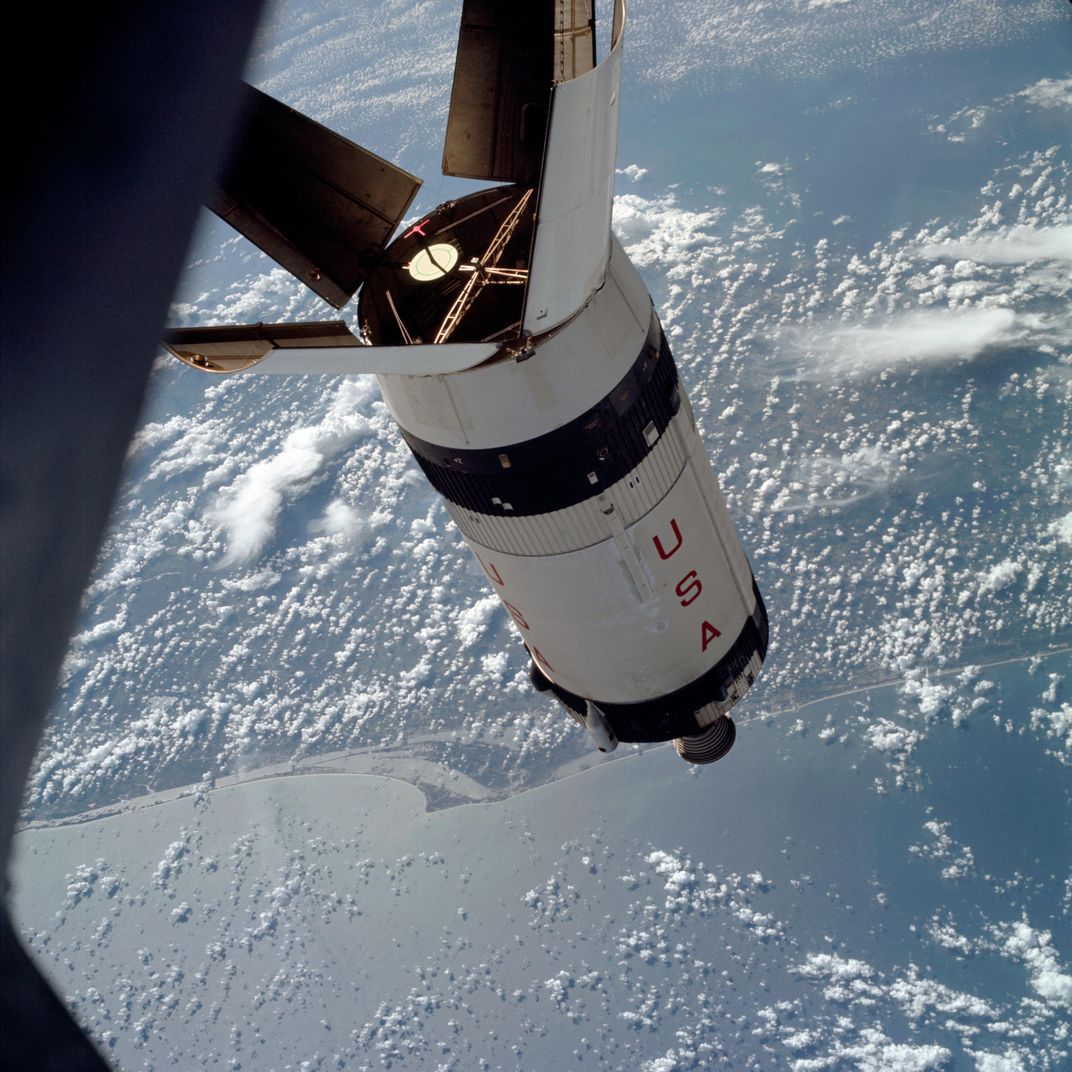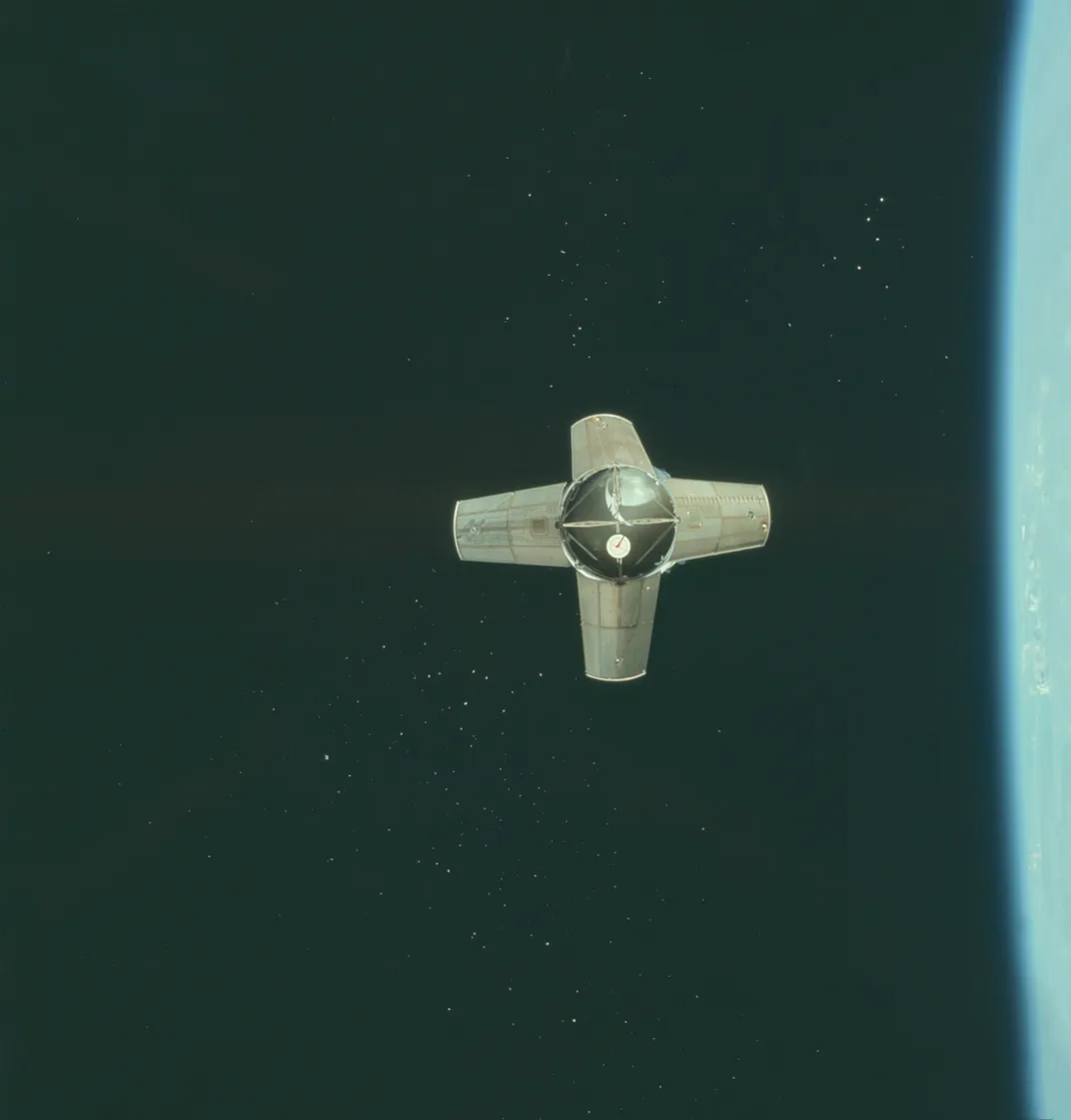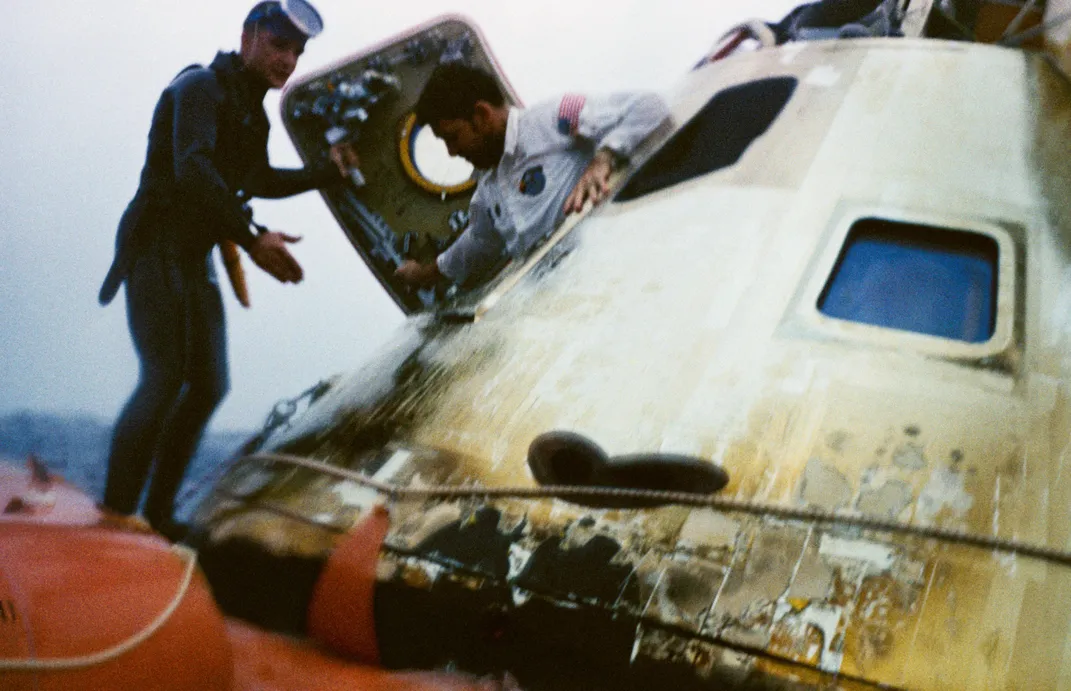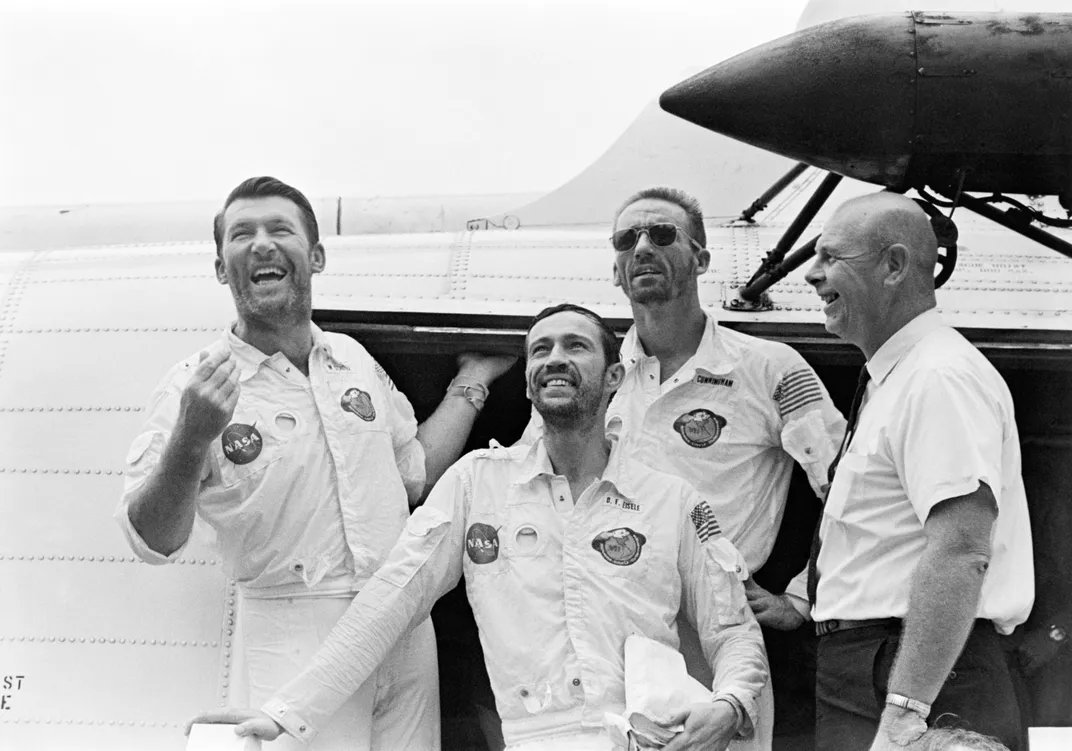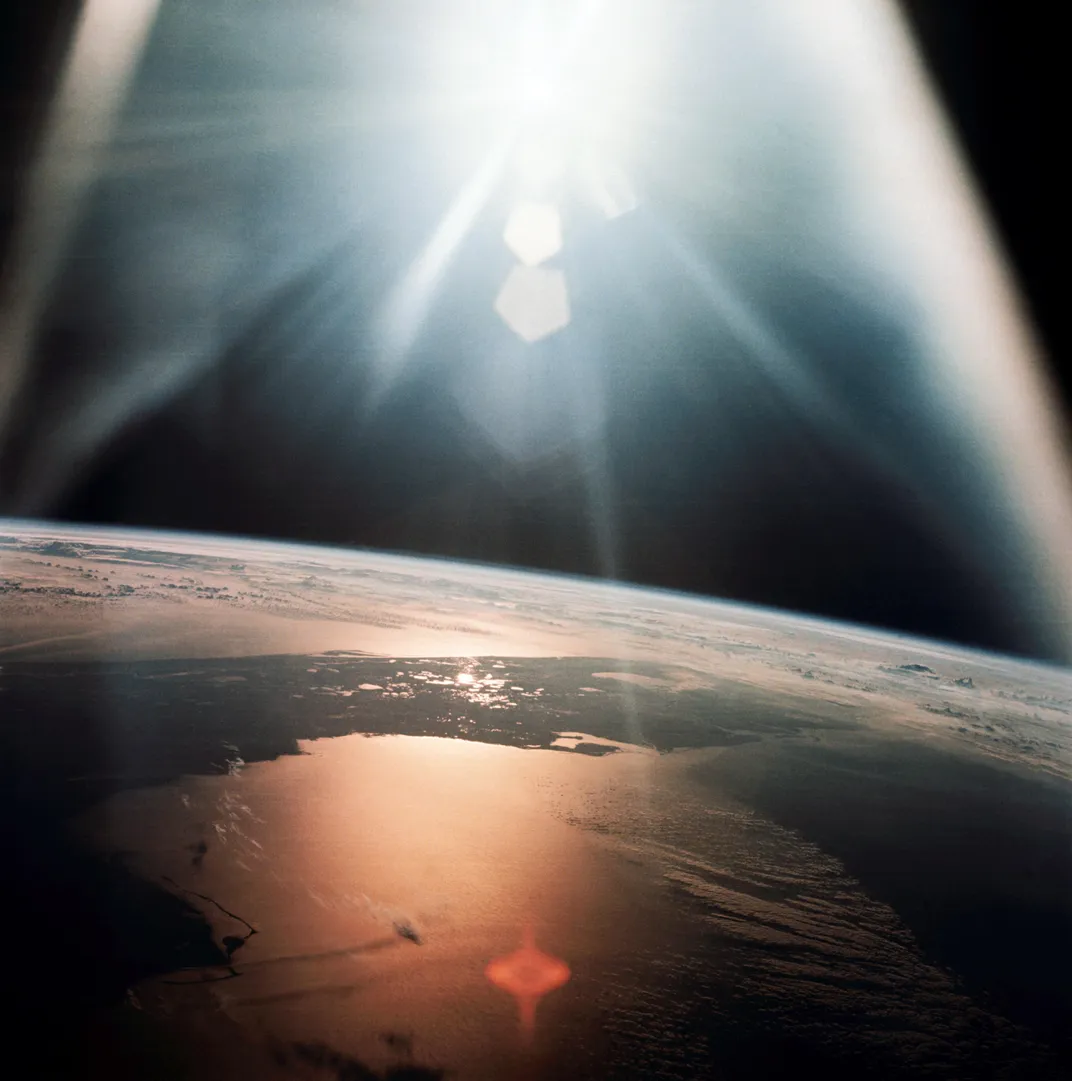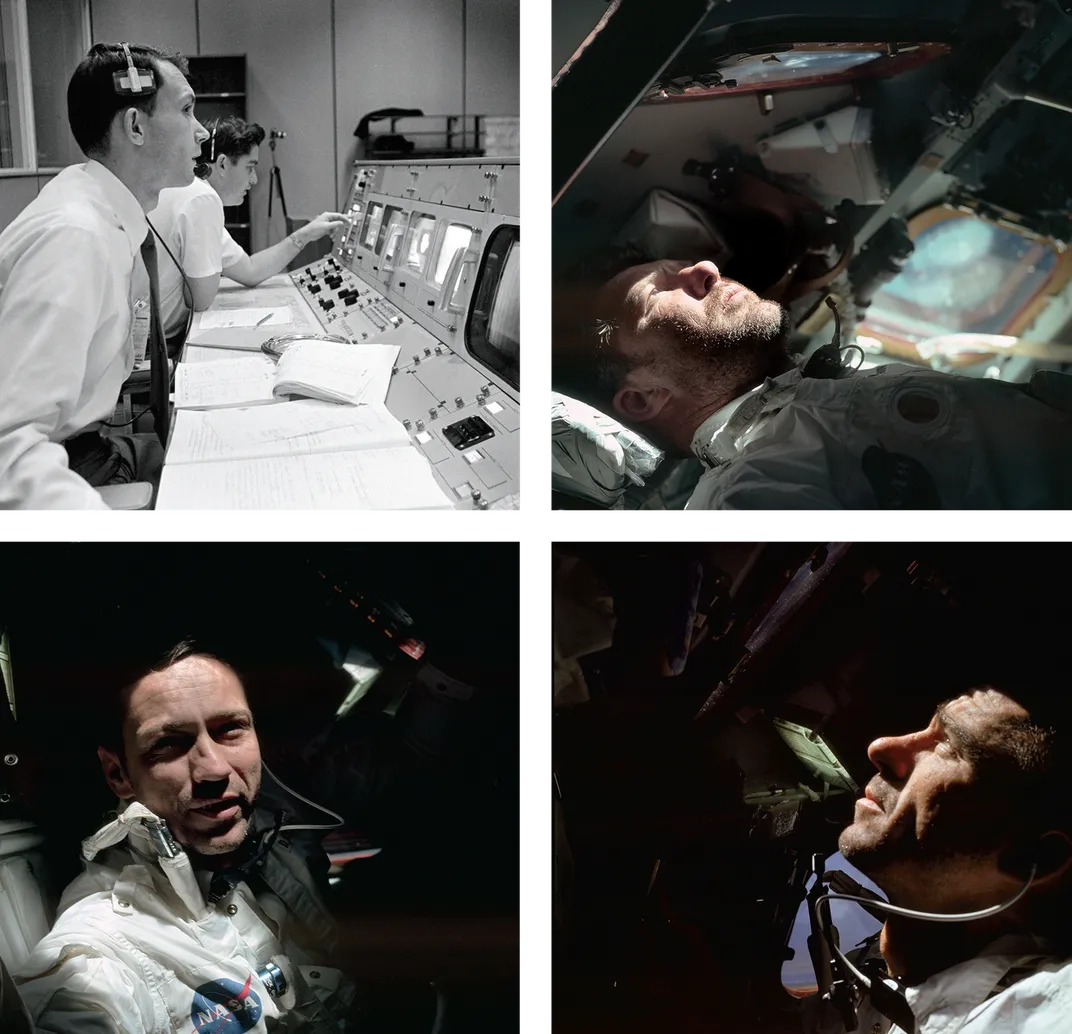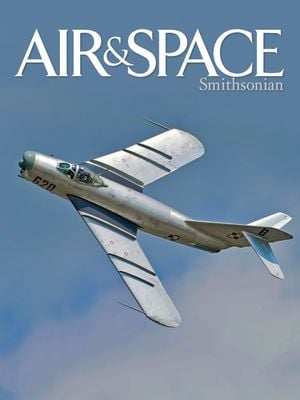The Flight (and Fights) of Apollo 7
With barely a year left in the decade, three astronauts knew it was up to them: Keep Kennedy’s promise or kill it.
/https://tf-cmsv2-smithsonianmag-media.s3.amazonaws.com/filer/ca/1b/ca1b55e5-5e69-447f-a139-e9b92f36b456/02q_on2018_launch68-hc-641hr_live.jpg)
Apollo 7 rose on a pillar of flame from Kennedy Space Center’s Pad 34 on October 11, 1968. The launch was not just the achievement of a single mission but confirmation that NASA had recovered from the searing setback of the Apollo 1 fire that had killed three astronauts 21 months earlier. Overlooked today, Apollo 7 was an indispensable test of NASA’s redesigned moon ship. If the crew could demonstrate the spacecraft’s performance, the success would jump-start a rapid sequence of missions—four in eight months—leading to a lunar landing. Failure would likely forfeit any hope of reaching John F. Kennedy’s goal for a moon landing by 1970 and open the door to yet another Soviet space triumph.
Crew of the Phoenix
The deaths of astronauts Gus Grissom, Ed White, and Roger Chaffee in the January 1967 launchpad fire forced NASA and contractor North American Rockwell to scrutinize and refine the design of Apollo 7’s spacecraft 101, an improved model of the command and service modules. The forced stand-down gave engineers time to install a quick-opening crew hatch, a planned upgrade that hadn’t made it into Apollo 1. They scrubbed the cabin of ignition sources and flammable materials and added emergency breathing masks and a fire extinguisher.
Apollo 1’s backup crew was immediately called up for Apollo 7. (Originally the two flights were called AS-204 and AS-205. The former was renamed Apollo 1 after the fire; Apollo missions 2 through 6 were uncrewed.) This would be the third spaceflight for crew commander Wally Schirra, 45, an accomplished U.S. Navy test pilot and one of the original Mercury Seven. He flew a successful six-orbit Mercury flight in Sigma 7 in late 1962, and maneuvered Gemini 6 to the world’s first space rendezvous in December 1965. On the ground, Schirra was irreverent and a master of the “gotcha” practical joke, but in flight he was a crisp, no-nonsense space pilot. His cool decision to not eject when Gemini 6’s engines shut down just before liftoff saved the mission; three days later he and Tom Stafford blasted off to meet Gemini 7 in orbit.
When the fire thrust Schirra into the commander’s slot on the make-or-break Apollo 7, his easy-going personality disappeared. The new commander, with indisputable evidence of the risks his crew would be taking, now had immense leverage with management at NASA and North American, and he used it. In conference rooms or on the spacecraft assembly line, Schirra got his way.
Command module pilot Donn Eisele (pronounced “eyes-lee”), a 38-year-old Ohioan and graduate of the U.S. Naval Academy, had taken an Air Force commission out of Annapolis and in 1960 graduated from the Aerospace Research Pilot School. Chosen with the 1963 astronaut class, Eisele became Apollo 7’s command module pilot, well versed in its systems, especially the new digital guidance and navigation computer, crucial for lunar flight.
Walt Cunningham, 36, flew Marine night fighter missions in Korea, then served as a RAND Corporation physicist before being selected alongside Eisele in NASA’s third astronaut class. He was Apollo 7’s lunar module pilot, but with the Grumman-built lander still six months from being flight-worthy, Cunningham trained as the crew’s all-around systems expert.
For this critical mission, the three astronauts had four essential objectives: to confirm the livability and safety of the redesigned command module over the length of a lunar mission, prove the reliability of the module’s big rocket engine needed for entering and leaving lunar orbit, test the navigation and guidance system’s ability to direct an orbital rendezvous, and execute a precise reentry and splashdown.
As NASA readied the Apollo 7 capsule, which would perform all these tests in Earth orbit, the Soviets launched a series of Zond spacecraft on a looping path around the moon and back. These obvious rehearsals for a cosmonaut lunar flyby seemed to presage a Soviet piloted lunar circumnavigation before the end of 1968. NASA’s Apollo spacecraft manager George Low suggested to Manned Spacecraft Center director Robert Gilruth in August 1968 that a successful Apollo 7 should be immediately followed by a lunar orbital flight. Delays in the construction of the lunar module, Low argued, could mean that Apollo 8’s original mission—a test of the command and lunar modules in Earth orbit—would be impossible in 1968. Without the lunar module, Apollo 8 would merely repeat the flight of Apollo 7—and would burn five months of schedule that NASA could ill afford to lose. To Low, sending Apollo 8 to lunar orbit was the only logical choice to build momentum and preempt the Soviets. But shooting for the moon was impossible unless Apollo 7 proved the spacecraft was reliable and safe.
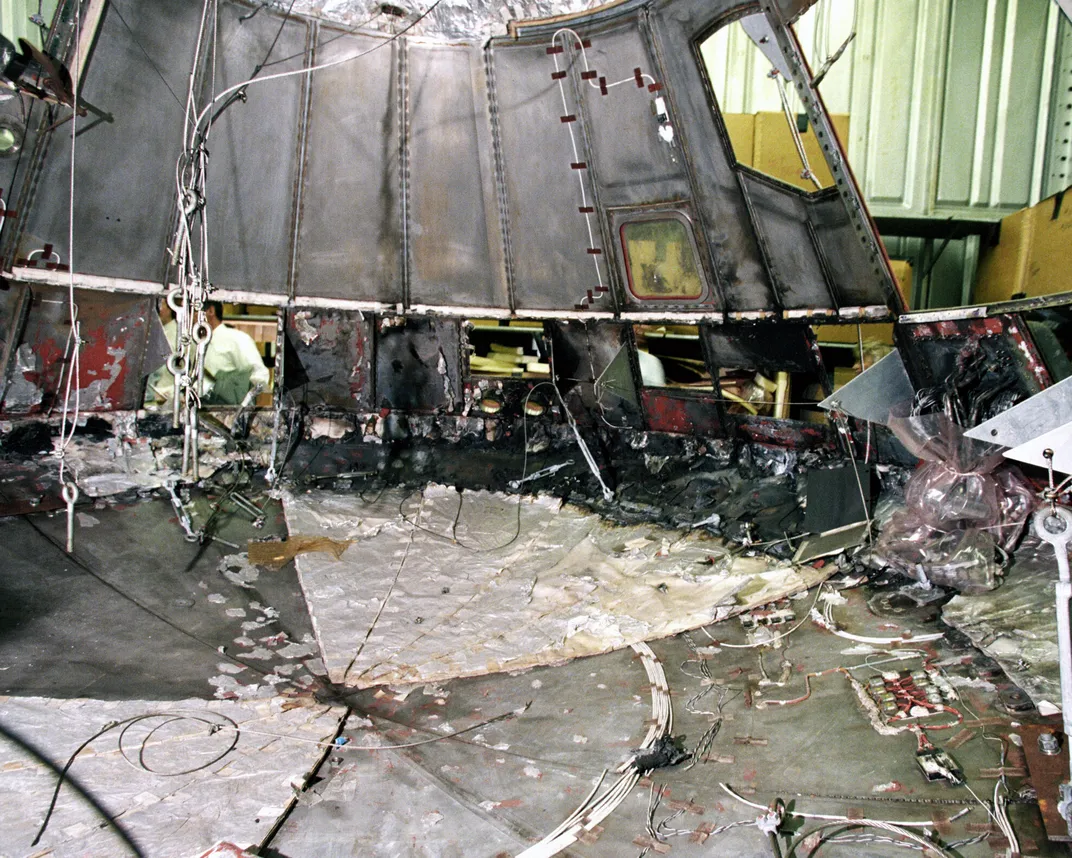
To Launch or Not to Launch
With the crew strapped in atop a Saturn IB on October 11, 1968, high-altitude winds threatened to scrub the liftoff. If the mission were forced to abort after launch, the easterly winds might carry the command module, designed for an ocean splashdown, back over the Cape to a terrestrial touchdown. Its early-model Block I couches would likely not protect the crew from serious injury.
Managers decided to waive the wind restriction, but Schirra didn’t want to give up the flight rule’s safety margins. “That would essentially have been a death penalty,” Schirra said in a 2002 interview with author Francis French. “It was really a case of ‘someone wanted to go.’ I fought that, until I became rather difficult, and I finally yielded, with great concern.” This prelaunch dispute was the prelude to a tug of war over command decisions for the rest of the mission.
The rocket shouldered Apollo 7 off the launchpad at 11:02:45 a.m. The booster’s eight engines, generating 1.6 million pounds of thrust, washed the launch pedestal in a brilliant splash of orange-white flame that at least partly wiped out those nightmares of Apollo 1, though it didn’t immediately seem that way to the first crew to ride a Saturn rocket into space.
“When I heard ignition, it developed a real violent, shaking sound. It’s very unreal. At liftoff, I could barely see the darn clock…. I thought the world was coming to an end,” reported Schirra. “The spacecraft shook and rattled furiously,” wrote Eisele in Apollo Pilot, a memoir published posthumously in 2017. “I thought the Command Module was going to snap right off the top of that Saturn.”
As the first stage burned out and detached, its solid fuel retro-rockets fired to ensure separation. “You could see kind of a sheet of flame come by the hatch,” Eisele wrote of the exhaust. As the second stage lit up, “the G-meter went from zero to half a G, and we were pushed gently back against our seats.” Eisele jettisoned the launch escape tower with “a loud crack and a brief, muffled roar.” Ten minutes and 27 seconds after liftoff, the second-stage engine shut down, inserting Apollo 7 into its elliptical low Earth orbit.
The first major exercise began about three hours after launch, as Apollo 7 finally cut loose the second stage, which was to be used as a rendezvous target. On future missions the lunar module would ride sandwiched between this stage and the service module. Schirra flew using four sets of reaction control system thrusters, situated around the cylindrical service module, to pitch the spacecraft around to face the target representing the lunar module and close in to as if to dock. During his first space rendezvous in 1965, Schirra had flown to within a foot of Gemini 7; now he lined up smoothly with the target and easily flew in formation for 20 minutes. Then he thrust away for 16 seconds, changing Apollo 7’s orbit to put 76 miles between his spacecraft and the spent second stage to set up the next day’s rendezvous exercise.
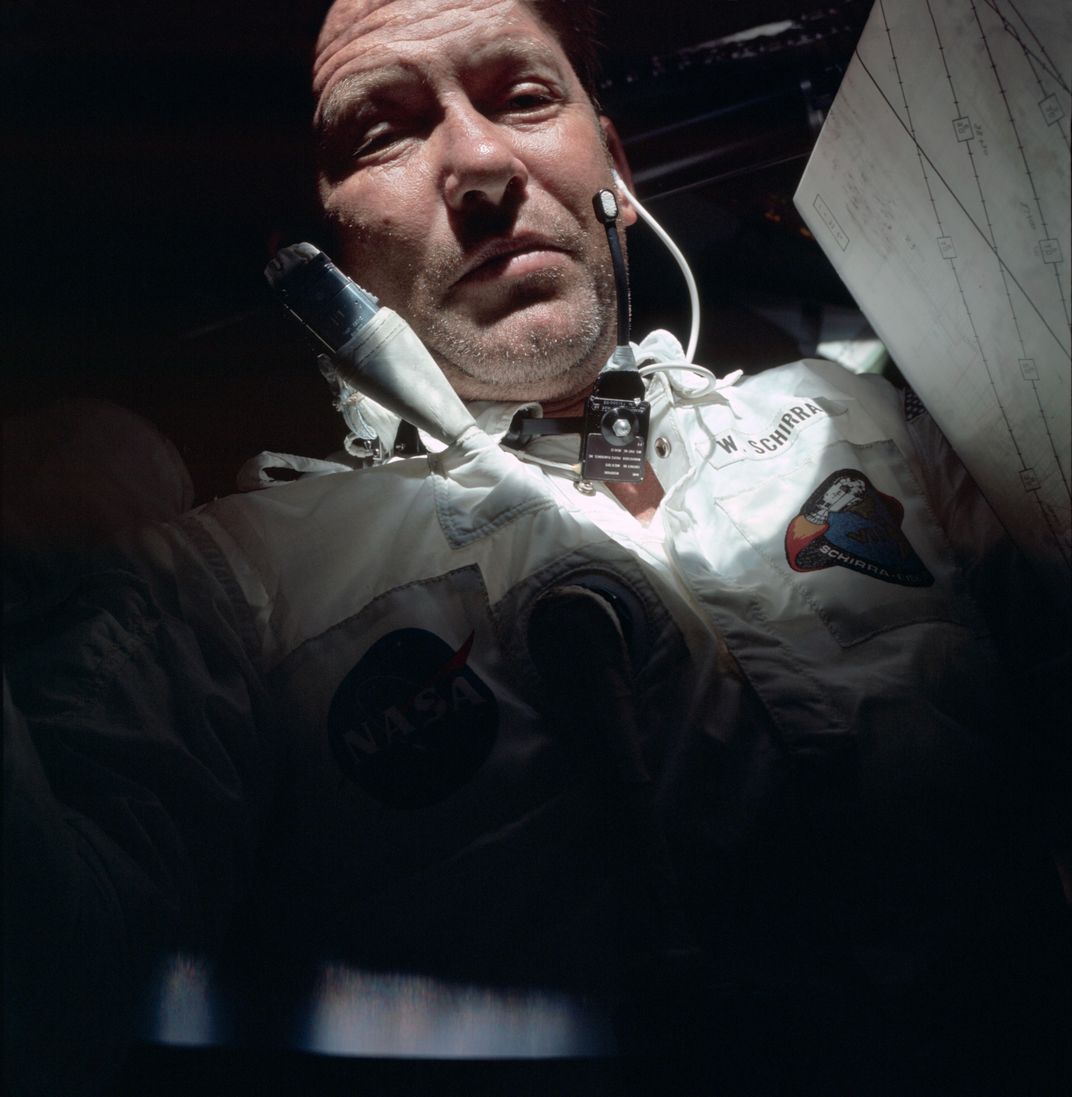
Cold and Fatigued
Some 15 hours into the mission, Schirra reported to Mission Control that he had come down with a head cold. Because congested sinuses don’t drain in microgravity, a common cold in space is exceptionally miserable. Added to the puffy face and headaches often experienced while adapting to weightlessness, the cold’s onset made Schirra tired and understandably irritable. Still miffed from the countdown dispute and beset by his cold, he was unreceptive to Houston’s early suggestion to slip new engineering tests into an already busy flight plan.
Late in the first day, Mission Control asked the crew to power up the TV system ahead of schedule to check the circuits. It wasn’t an actual broadcast, but it wasn’t in the flight plan either. Schirra was having none of it: “You’ve added two burns to this flight schedule, and you’ve added a urine water dump; and we have a new vehicle up here, and I can tell you at this point TV will be delayed without any further discussion until after the rendezvous.”
In a rare intervention, chief astronaut Deke Slayton came on the line to point out that the request was only to plug in the camera and flip on the power switch. Schirra was adamant: “We do not have the equipment out…we have not eaten…. At this point, I have a cold. I refuse to foul up our timelines this way.” Slayton yielded, but flight controllers were startled by Schirra’s abruptness.
Later, when the little red light did come on for the first live TV broadcast from an American spacecraft, Earth audiences were treated to a lively scene inside the command module. The smiling crew displayed hand-lettered cue cards reading, “From the Apollo Room, High Atop Everything” and “Keep Those Cards and Letters Coming In, Folks.” These apparently amiable astronauts delivered to NASA a solid public relations coup.
Despite the sunny mood on-camera, the astronauts were tired. With NASA’s scattered ground stations limiting communications to an average of only five minutes per 90-minute orbit, Houston wanted at least one astronaut always on duty to monitor the fledgling craft. Eisele turned in first, slipping beneath the crew couches, while Schirra and Cunningham kept watch. “I had trouble sleeping the whole time we were up there,” Eisele later wrote, “on account of the weird hours of my sleep schedule and Walt and Wally’s activities and conversation…. After that [first] night I’d get by on catnaps for two days and collapse every third night for a solid six to eight hours.” His two crew mates slept no better.
First Rendezvous
After a night of fitful rest, Apollo 7’s crew kicked off their rendezvous exercise with a test of the powerful Service Propulsion System engine. On lunar missions, the engine’s 20,000 pounds of thrust would drop Apollo crews into orbit around the moon and later blast them home again. It simply had to work, every time.
When the engine ignited, Schirra yelled down to Houston, “Yabba Dabba Do!—That was a ride and a half!” Eisele remembered the intensity: “It’s a real boot in the ass when it lights off.” The inaugural nine-second burn went perfectly. With Eisele feeding sextant sightings of the spent second stage into the guidance computer, the crew reeled off a series of burns to close in on it. Just short of 30 hours after launch, Apollo 7 had closed to within 70 feet of the tumbling rocket. For 25 minutes, Schirra pirouetted nimbly around it for a photo inspection. The rendezvous demonstrated that even without radar data, an Apollo command module pilot could find and rescue the crew of a crippled lunar module trapped in a low, errant orbit.
The crew fired up the SPS engine a total of eight times without a hitch. They tested fuel cells and battery chargers, exercised the cooling capacity of the thermal control system, and put Apollo 7 into “barbecue mode,” rolling the command and service modules slowly around their long axis to distribute heat loads evenly over the spacecraft skin. Eisele gave the sextant and telescope optics and the MIT-designed guidance computer a thorough workout. Although flurries of vented, frozen urine crystals sometimes obscured his star targets, he proved the optics could sight accurately enough to steer Apollo to and from the moon even without tracking data from Earth. By the end of the mission’s fifth day, flight director Glynn Lunney estimated the team had accomplished 70 to 75 percent of the planned test objectives.
Only a few glitches turned up, most easily fixed. Window seals outgassed, fogging portions of all five windows. One of the fuel cells occasionally ran hot, and the crew’s solid waste disposal system proved both messy and odoriferous. Even today, astronauts cringe at the mere mention of “Apollo bags,” still flown in case of a space toilet breakdown.
Smooth Flight and Rough Edges
Long days in space were taking their toll. As Eisele tracked an Earth landmark on day 9, Schirra radioed that repeated thruster firings would be needed to maintain the tracking attitude against atmospheric drag. Then, a sudden blast: “I wish you would find out the idiot’s name who thought up this test. I want to find out, and I want to talk to him personally when I get back down.”
A startled capcom answered, “Roger, Wally. Good morning.”
Eisele added, “While you are at it, find out who dreamed up P22 horizon test; that is a beauty also.”
On the ground, the reaction was puzzlement and exasperation. Flight director Gerry Griffin says that “Wally was a good friend. He’d been a big joker, a pun-master…but when he got in orbit on Apollo 7, he seemed to think that Mission Control wasn’t doing something right. The friction after the long preparation together for the flight surprised everyone. We’d always had respect between the two parties—crew and ground. This was a break from that.”
In 1994, lead flight director Glynn Lunney said, “I was pissed off about it. That was an affront and inappropriate and, frankly, insubordinate.” Recently, he adds that the comments “didn’t affect our execution, but people were angry in the control center about it. The effect was a loss of cohesion between the ground and crew…. It was lucky that no tough decisions were needed during the mission.”
Schirra’s obstinacy reached a frustrating climax near mission’s end, when he decided the crew would not wear their helmets for reentry. During descent, the cabin pressure would rise from 5.9 to 14.7 psi—back to sea level pressure. Schirra, still suffering from clogged sinuses and ears, feared the sealed helmet would keep him from pinching his nostrils to equalize the pressure, perhaps rupturing an eardrum.
Mission Control reminded Schirra that helmets protected the crew from cabin leaks, rapid depressurization, and landing impact forces. Schirra insisted that chances of a leak were minimal and that as commander, accepting those risks was his call. To cushion heads and necks against a hard splashdown, the astronauts taped rolls of empty plastic food packages to their couch headrests.
The discussion over helmets heated up over several days, finally boiling over on the radio link less than two hours before reentry.
Capcom (Deke Slayton): Okay. I guess you better be prepared to discuss in some detail when we land why we haven’t got them on. I think you’re too late now to do much about it.
Schirra: That’s affirmative. I don’t think anybody down there has worn the helmets as much as we have…
Capcom: The only thing we’re concerned about is the landing. We couldn’t care less about the reentry. But it’s your neck, and I hope you don’t break it.
Schirra: Houston, this is Apollo 7. I’ll be prepared to talk about the whole mission when we get back.
Tom Stafford, Schirra’s backup, was listening at the Capcom console and recalls Slayton’s final directive: “Wally, I am ordering you to put on your helmet.” Apollo 7’s commander got in the last word: “Deke, you can come up here and put it on.”
Stafford watched as Mission Control’s legendary director Chris Kraft, red-faced, strode down to get an explanation for what he thought was Schirra’s insubordination. Stafford could only shrug: “Wally can do what he wants to do. He’s up there. He’s calling it real time.” Schirra said in 1994: “In this case I had a cold, and I’d had enough discussion with the ground, and I didn’t have much more time to talk about whether we would put the helmet on or off. I said, essentially, I’m on board, I’m commanding. They could wear all the black armbands they wanted if I was lost or if I lost my hearing. But I had the responsibility for getting through the mission.” Kraft didn’t like it, but he later conceded in his memoir that “Schirra was exercising his commander’s right to have the last word, and that was that.”
On October 22, Apollo 7 splashed down 200 nautical miles south of Bermuda, just a mile from the aim point. The helmetless astronauts were no worse for wear. Cunningham wrote in his memoir, “A near-perfect mission was behind us. Suddenly the goal of landing men on the surface of the moon was very close.”
Reckoning
Just after splashdown, Apollo program director Air Force Lieutenant General Sam Phillips told reporters that “Apollo 7 goes into my book as a perfect mission. We accomplished 101 percent of our objectives.” Even Kraft judged that “Schirra and his crew did it all—or at least all of it that counted … [T]hey proved to everyone’s satisfaction that the SPS engine was one of the most reliable we’d ever sent into space. They operated the Command and Service Modules with true professionalism.”
Technical success, however, couldn’t wipe out management’s dissatisfaction with the “bitchiness”—Kraft’s word—that Schirra, and sometimes Donn Eisele, had displayed in flight. Cunningham recalls that when the astronauts were delivered back to Cape Canaveral, “we went up to the office there, where Deke was waiting. Deke took Wally to another room and spent about 10 minutes laying down the law.”
Although Kraft wrote in his memoir that Schirra had “done a good technical job, and nothing could change that,” the flight control chief also told Deke Slayton “straight out that this crew shouldn’t fly again.” Because of their perceived support of Schirra’s behavior, “Cunningham and Eisele had me worried. I didn’t want to see either of them in a command position, and in my talks with Deke, he felt the same.”
“Deke never said ‘boo’ to us,” says Cunningham. Nevertheless, he did hear rumors of Kraft’s wish to ground the pair. Instead of a moon flight, Walt Cunningham was assigned as lead astronaut on the Skylab program, calling it his “biggest contribution to NASA.” Stiff competition for Skylab’s nine crew slots, and Deke’s perception that his physics experience made Cunningham more of a scientist-astronaut than command material, left him on the ground. Yet he is still unabashedly proud of the job turned in by his Apollo crew. “To this day, Apollo 7 is still the longest, most ambitious, most successful first test flight of any new flying machine ever,” says Cunningham.
As for Eisele, his Apollo 7 reputation and a 1970 divorce—embarrassing for a space agency still determined to point to the astronauts as American-as-apple-pie role models—diminished his fortunes with NASA, and he never flew in space again. Eisele wrote, “We were insolent, high-handed, and Machiavellian at times. Call it paranoia, call it smart—it got the job done. We had a great flight.”
Eisele died in 1987; Schirra, in 2007. Time has erased nearly all the tensions Apollo 7 raised five decades ago. In 2008, Kraft sent Cunningham this message, played during a celebration of the mission’s 40th anniversary at the Frontiers of Flight Museum in Dallas: “You’ve done well by yourself, you’ve done well for NASA, and I am frankly, very proud to call you a friend.”
Three weeks after the Apollo 7 crew returned, NASA administrator Thomas Paine green-lighted Apollo 8 to launch in late December and orbit the moon. Apollo 7 had delivered NASA from its trial by fire—it was the first small step down a path that would lead another crew, nine months later, to the Sea of Tranquility.
